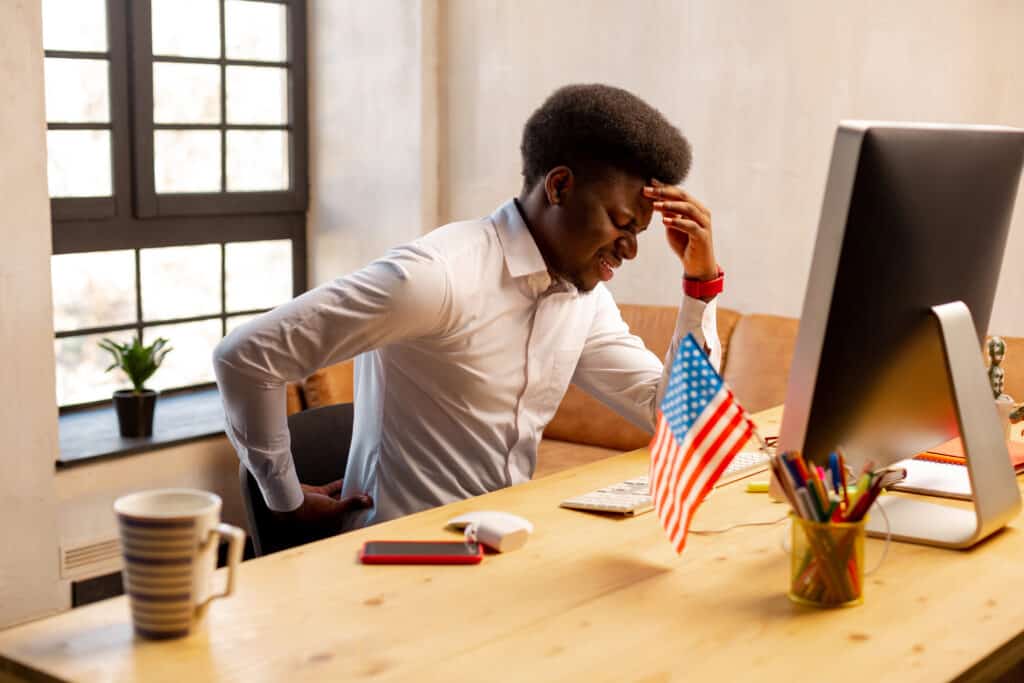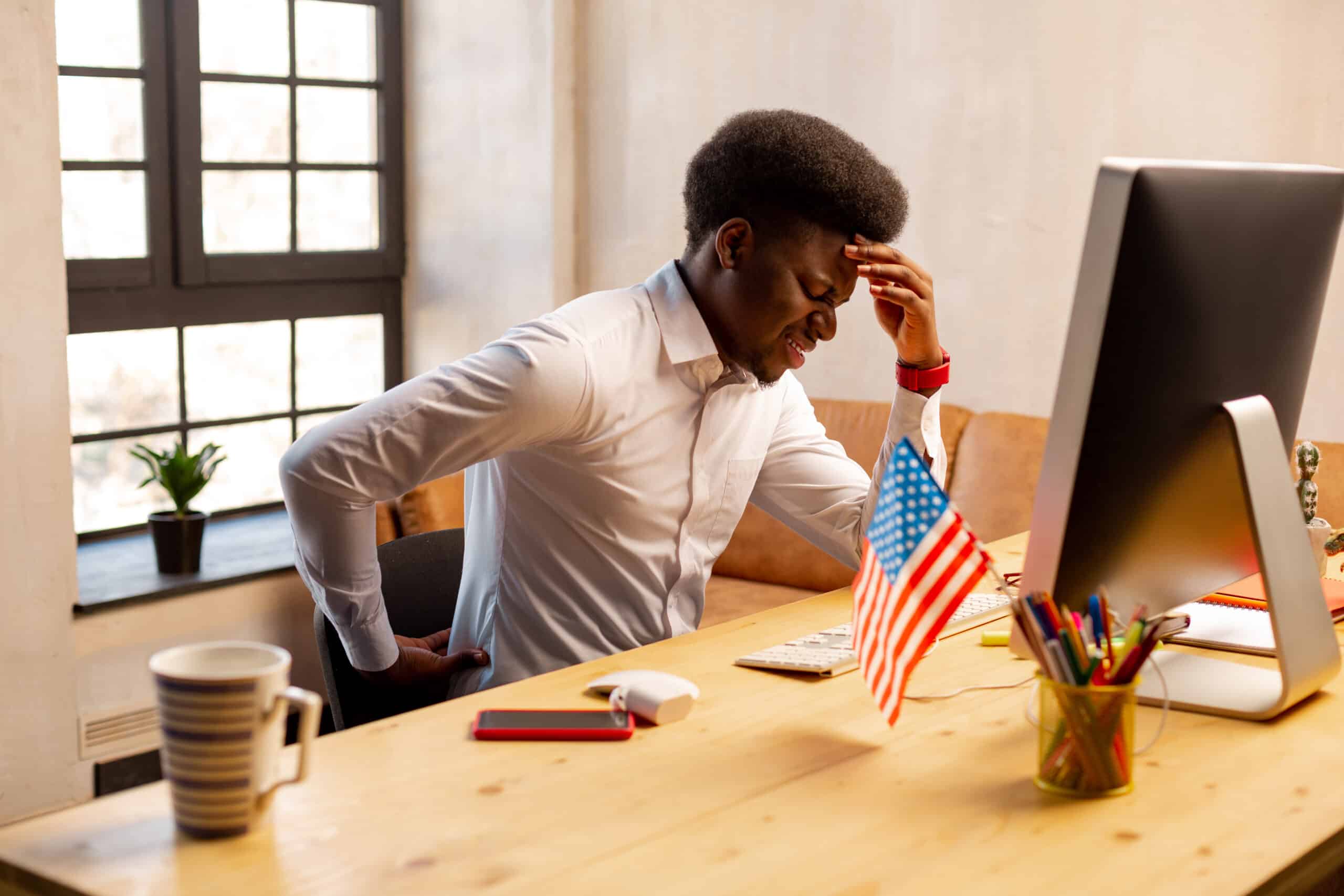One of the health issues many Americans have to deal with is low back pain. So much so that 85 percent of the population will experience at least one episode of back pain during their lifetime according to research. Many in this group end up dealing with back-related problems on and off for the rest of their life. One cause of this debilitating health concern is linked to prolonged periods of sitting too much.
“Physical inactivity is as harmful to your health as high blood pressure, high cholesterol, and smoking.”
Steven Blair, PhD, Arnold School of Public Health at University of South Carolina
Not Enough Daily Physical Activity
A sedentary person averages between 1,000 and 3,000 steps a day while an average healthy adult walks about 5,900 steps daily. The average number of daily steps for men was 7,192 and for women 5,210 according to a study published in the journal Medicine and Science in Sports and Exercise by Tudor-Locke and colleagues. It is not unusual for active individuals to consistently take 10,000 steps a day while highly active individuals can reach 15,000 to 25,000 steps a day and beyond!
As someone begins to introduce more movement into their day, this means they are spending less time sitting over the course of a day. Any type of sitting increases the pressure or load on the back musculature. One of the worst culprits is flying. One survey found 88 percent of people who fly experience back or neck pain following a flight. If you fly frequently for business, good luck, unless you’re flying first class.
Amount of Pressure on the Spine
The least amount of disc pressure placed on the lumbar spine, known as intradiscal pressure, is at its lowest while supine or lying down on your back (25 kg of pressure). This pressure increases slightly when rolling onto your side (75 kg). When you get up and stand, pressure once again increases (100 kg) as it does when you lean forward from a standing position (150 kg). Holding a weight and leaning forward causes the pressure to increase (220 kg) on the lumbar spine. During sitting, which many of us do for 8 hours a day, the pressure placed on the lumbar disc is approximately 140 kg. Leaning forward while seated increases that pressure on the lumbar spine to 185 kg.
The position placing the highest pressure (275 kg) on the discs in the lumbar spine occurs in a seated position, leaning forward and bearing weight.
Some additional information for you. When you’re walking, the pressure is 2.5 times your bodyweight and can increase to 3-4 times your bodyweight when running.
Restore Your Back With a Hook Lying Position
This is one of the best positions to place the body in when trying to relax the back muscles. Lie in a supine position (on your back) with the knees bent and feet flat on the floor (see photo below). Take 5 long, slow breaths and let the body relax; imagine the body is melting into the floor. This allows the pelvis to slowly transition back into a neutral position. Relax and maintain this position for 3-5 minutes. This pose is also called a “corrective restorative pose.” You can also lift the legs off the floor and rest on a chair or stability ball, maintaining a 90/90 – ninety degree angle in hips and knees.


Due to tight or weak muscles (or combination of both) and restrictive connective tissue, the pelvis may eventually “tilt” forward or backward. The ideal anatomical position, however, is a neutral pelvis. The body functions and performs at its best while in this position. Sitting too much or bad posture can result in the hip dysfunction.
A healthy spine has three curves, a slight concave found in the cervical and lumbar regions while the mid-region or thoracic spine is more convexed. Various issues arise when we sit for prolonged periods of time in a chair, couch, or on a plane, when this occurs, the shape of the spine moves more into a “C” shape versus “S” shaped position.
Common Symptoms of Anterior Pelvic Tilt
The easiest way to see if you have an anterior pelvic tilt (APT) is to lie on a table with both legs hanging off the edge of the table. Bend one knee and pull it towards the chest. If there is an issue with the pelvis, the back of the opposite leg will raise off the table. If this happens, the pelvis is probably incorrectly aligned. Perform the test on both sides.
There are many causes of APT, such as, muscle imbalance caused by weakness, old injuries, poor posture, excessive foot pronation, etc. A good exercise prescription may involve focusing on the four symptoms below, seen in RED. Typically, a person will begin to feel better as the gluteal and abdominal muscles get stronger and the hip flexors and back muscles become more supple through stretching. If you sit most of the day, expect the hip flexors and back to be excessively tight. Below are some of the symptoms often associated with APT.
- Hyperextended knees while standing
- Chronic low back tightness
- Tight hamstring muscles
- Low back pain
- Weak gluteal muscles
- Weak abdominals
- Tight hip flexors
- Tight erector spinae
Correcting APT Through Movement
As with anything else, the first step is having the awareness that a problem exists. From there, limit your sitting to 15-30 minutes at a time, getting up often to move and stretch. Build a standing work station if necessary or switch between the two. One option could be a kneeling chair for the office, it’s considered a good choice for sitting. If you need to take long calls – take “walking conference calls.” High on the list should be daily movement, like walking, and various forms of exercise like yoga, pilates and strength training. The goal is finding what’s tight and lengthen it and what’s weak work to strengthen it. Below are a few exercises that you should think about adding to your exercise routine using the Jefit app to help maintain a strong, functional core.
Check in daily with posture and body mechanics when sitting, standing, moving and of course during exercise. Try this, stand tall with feet hip width-apart and arms relaxed by your side. Take a deep breath in, exhale and relax. Place your finger on your navel. Think about “pulling-in” your navel in toward your spine. You may feel a slight contraction in your abdominal area and maybe your low back will relax too. This is what it feels like when the pelvis is in a neutral position and you need to be cognizant of maintaining this throughout the day. Work on holding this during walking and exercise as a first step.
Specific Exercises to Improve Neutral Pelvis
The pelvis functions optimally when it’s able to maintain a neutral position versus “slipping” into a forward/backward tilt. The following list of exercises will increase strength and improve flexibility in the hip area. Good luck & stay strong together with Jefit.
Supine Bent Knee Rotation
Hook Lying Position
Kneeling Hip Flexor Stretch (with posterior pelvic tilt)
Forearm Plank (maintain a posterior pelvic tilt, activate the glutes)
Stay Strong Together with Jefit App
Millions of members have had great success transforming their bodies using the Jefit app. The app is a customizable workout planner, training log, can track data and share workouts with friends. Take advantage of Jefit’s huge exercise database for your strength workouts. Visit our members-only Facebook group. Connect with like-minded people, share tips, and advice to help get closer to reaching your fitness goals. Stay strong with Jefit.
- Is HIIT a Safe and Effective Training Option for a Novice? - May 15, 2024
- What You Need to Know to Jump Start Fat Loss - May 13, 2024
- Do Regular Ice Baths Help Improve Performance? - May 10, 2024


Pingback: Are You Focusing Enough on Mobility in Workouts? | Jefit - #1 Gym workout app
Pingback: Causes of Back Pain as Explained by Orthopedic Surgeon | Jefit - #1 Gym / Home workout app
Pingback: All You Need To Know For Effective Fat Loss | Jefit - #1 Gym / Home workout app
Pingback: Three Helpful Tips When Recovering From An Injury | Jefit - #1 Gym / Home workout app
Pingback: What Are the Best Options for Managing Chronic Pain? | Jefit - #1 Gym / Home workout app